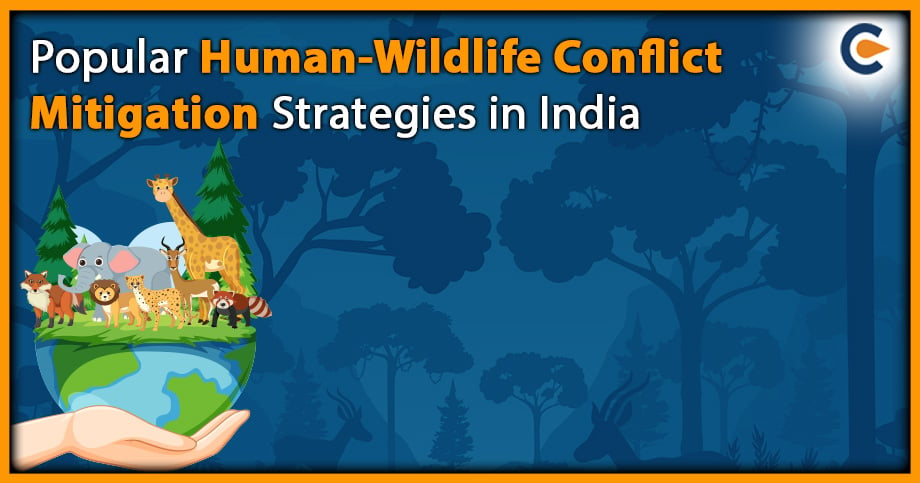The Human-Wildlife Conflict (HWC) Mitigation Strategy aims to reduce and manage conflicts between humans and wildlife, which can occur when the needs and behaviours of wildlife conflict with those of people. These conflicts can arise from various reasons, including competition for resources such as water and food, habitat loss or fragmentation, or human activities that disrupt wildlife behaviour or migration patterns. The vision of the Human-Wildlife Conflict Mitigation Strategy is to create a world where people and wildlife can coexist in harmony, where nature is protected and valued, and where local communities benefit from conservation efforts. The mission of the HWC mitigation strategy is to reduce and manage conflicts between humans and wildlife while ensuring the safety and well-being of both. The mission aims to achieve this by implementing effective and sustainable HWC mitigation strategies based on scientific research, community engagement, and stakeholder participation.
Human-Wildlife Conflict Mitigation Strategy
HWC mitigation strategies aim to find solutions to minimize negative impacts on humans and wildlife. The strategy may include measures such as:
- Habitat Management: Managing and restoring wildlife habitats to reduce conflicts, such as restoring natural corridors for wildlife movement or creating buffer zones between human settlements and wildlife habitats.
- Human Behaviour Modification: Changing human behaviour to reduce conflicts, such as reducing waste or food sources that may attract wildlife and enforcing rules and regulations restricting human activities in sensitive areas.
- Technology-Based Solutions: Using technology to reduce conflicts, such as installing fencing or electric fences around crops or livestock enclosures, using motion-activated lights or alarms to deter wildlife, and deploying drones or other surveillance tools to monitor wildlife movements.
- Community-Based Solutions: Involving local communities in finding solutions to HWC, such as encouraging them to develop sustainable livelihoods compatible with wildlife conservation, providing education and awareness about wildlife behaviour and habitats, and engaging local people in conservation efforts.
Guiding Principles of Human-Wildlife Conflict Mitigation
The HWC mitigation strategy can ensure effective, sustainable, and socially acceptable interventions, leading to positive outcomes for both humans and wildlife. The guiding principles of the Human-Wildlife Conflict Mitigation Strategy are:
- Science-Based: The HWC mitigation strategy should be based on sound scientific research and monitoring to ensure that the interventions are effective and sustainable.
- Participatory: The HWC mitigation strategy should involve stakeholders, including local communities, in developing and implementing interventions to ensure that the solutions are appropriate and culturally acceptable.
- Proactive: The HWC mitigation strategy should prioritize proactive measures that aim to prevent conflicts from occurring in the first place rather than reactive measures that focus on addressing conflicts after they occur.
- Adaptive: The HWC mitigation strategy should be adaptive and flexible, incorporating new information and adjusting interventions based on monitoring and evaluation results.
- Collaborative: The HWC mitigation strategy should foster collaboration among stakeholders, including government agencies, NGOs, local communities, and private sector organizations, to ensure a holistic approach to HWC management.
- Sustainable: The HWC mitigation strategy should be ecologically and socially sustainable and consider the long-term impacts of interventions on human communities and wildlife.
- Equitable: The HWC mitigation strategy should promote equity and fairness in decision-making, recognizing stakeholders’ different interests and needs, including vulnerable and marginalized groups.
Framework of Human-Wildlife Conflict Mitigation Strategy
In India, the Ministry of Environment, Forests and Climate Change (MoEFCC) have developed a framework for strategic planning for Human-Wildlife Conflict Mitigation Strategy. The framework consists of the following components:
- National Level HWC Management Plan: The MoEFCC has developed a National Level HWC Management Plan to guide HWC mitigation efforts nationwide. The plan includes a comprehensive assessment of the HWC situation in India, a description of the HWC management framework, and an action plan for addressing HWC issues.
- State-Level HWC Management Plans: Each state in India must develop its own State Level HWC Management Plan based on the national-level plan. The state plans should include a detailed assessment of the HWC situation, an analysis of the causes of HWC, and a set of actions to mitigate HWC.
- Habitat Improvement and Restoration: The MoEF&CC promotes habitat improvement and restoration as a key strategy for Human-Wildlife Conflict mitigation. The government provides financial and technical support to restore and improve degraded habitats, which can reduce competition for resources and mitigate HWC.
- Human Behaviour Modification: The MoEF&CC encourages adopting practices that modify human behaviour to reduce HWC. These practices include using deterrents like chilli powder, solar lights, and noise-making devices and promoting community-based conservation efforts.
- Capacity Building and Awareness: The MoEF&CC[1] provides training and capacity-building programs for forest officials, NGOs, and local communities to build their capacity to manage HWC. The government also promotes awareness campaigns to increase public knowledge about HWC issues and the importance of wildlife conservation.
- Conflict Resolution: The MoEF&CC supports the establishment of Conflict Resolution Committees (CRCs) at the village level to address HWC issues. These committees facilitate dialogue between local communities and forest officials to resolve conflicts and mitigate HWC.
Strategic Priority of Human-Wildlife Conflict Mitigation Strategy
- Strategic Priority A – Strategic Priority A for addressing the critical drivers of HWC in India involves identifying and addressing the underlying causes of HWC to prevent conflicts from occurring in the first place. Some of the key drivers of HWC in India include habitat loss, fragmentation, and degradation; human population growth and expansion; and human encroachment into wildlife habitats.
- Strategic Priority B – Strategic Priority B for reducing direct pressures leading to conflict situations involves taking measures to minimize the likelihood of human-wildlife conflicts when they do occur. Some direct forces that lead to conflict situations include crop and livestock depredation, property damage, and threats to human safety.
- Strategic Priority C – Strategic Priority C for making available information and data on HWC to decision-makers and field response teams involves ensuring that accurate and up-to-date information on HWC is available to those who need it. This includes decision-makers, field response teams, and other stakeholders involved in HWC mitigation efforts.
- Strategic Priority D – Strategic Priority D for reducing the negative impacts of HWC on humans and wildlife involves taking measures to minimize the adverse effects of HWC on both humans and wildlife. HWC can have a range of negative impacts, including economic losses, damage to property, and threats to human safety, as well as negative impacts on wildlife populations and their habitats.
- Strategic Priority E – Strategic Priority E for effectively implementing national, state, and local Human-Wildlife Conflict mitigation plans involves strengthening the financial and institutional structures that support HWC mitigation efforts. This includes ensuring that sufficient funding is available to implement HWC mitigation plans and that institutions responsible for implementing these plans have the necessary capacity and resources to do so.
Conclusion
Human-Wildlife Conflict Mitigation Strategy is a critical area of focus for promoting sustainable coexistence between humans and wildlife. HWC can negatively impact both humans and wildlife, including economic losses, damage to property, threats to human safety, and negative impacts on wildlife populations and their habitats. Effective HWC mitigation requires collaboration and coordination between government agencies, NGOs, local communities, and other stakeholders, as well as a focus on sustainable and equitable solutions that consider the needs and concerns of humans and wildlife. By implementing these strategies, a project proponent can promote sustainable coexistence between humans and wildlife, ensure the long-term benefits from their projects, and reduce the impacts on natural resources. The inputs of certified experts during reporting of mandatory assessment processes such as (Environmental Impact Assessment) EIA or EMP and planning such as wild conservation plan or forest clearance has proven beneficial in the overall success of developmental projects.
Also Read:
How To Carry Out EIA For Prior Environmental Clearance?
How Much Does An Environmental Impact Assessment Cost?
How To Obtain Environmental Clearance For Highway Projects?











